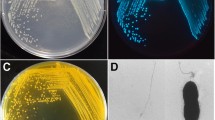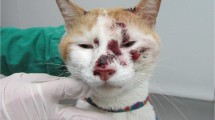Abstract
Oocysts were found in the feces of chickens (recipients) dosed orally with whole blood, liver, lung, or heart homogenates from chickens and turkeys (donors) inoculated 3 and 4 days previously with a mixture of 3.5×106 oocysts of chickenEimeria. No oocysts were found in the feces of recipients given spleen homogenates from these same chickens and turkeys and none were found in the feces of recipients given similar material from uninoculated donors. Intracellular sporozoites were found in the peripheral blood of a turkey inoculated with chickenEimeria. The results indicate that a small number of sporozoites are capable of invading and surviving for at least 4 days in the peripheral blood of chickens and turkeys.
Similar content being viewed by others
References
Desser SS (1978) Extraintestinal development of eimeriid coccidia in pigs and chamois. J Parasitol 64:933–935
Dubey JP (1975a) ExperimentalIsospora canis andIsospora felis infection in mice, cats and dogs. J Protozool 22:416–417
Dubey JP (1975b)Isospora ohioensis sp. n. proposed forI. rivolta of the dog. J Parasitol 61:462–465
Dubey JP (1979)Toxoplasma, Hammondia, Besnoitia, Sarcocystis, and other tissue cyst-forming ooccidia of man and animals. In: Kreier JP (ed) Parasitic protozoa. Academic Press, New York, pp 101–237
Duszynski DW (1981) Who are the coccidia and do we really know where they live? J Protozool 28:242–243
El-Kasaby A, Sykes AH (1973) The role of chicken macrophages in the parenteral excystation ofEimeria acervulina. Parasitology 66:231–239
Fayer R (1980) Epidemiology of protozoan infections. the coccidia. Vet Parasitol 6:75–103
Fayer B, Frenkel JK (1974) Comparative infectivity for calves of oocysts of feline coccidia:Besnoitia, Hammondia, Cystoisospora, Sarcocystis andToxoplasma. J Parasitol 65:756–762
Frenkel JK, Dubey JP (1972) Rodents as vectors for feline coccidia,Isospora felis andIsospora rivolta. J Infect Dis 125: 69–72
Frenkel JK, Dubey JP (1974)Hammondia hammondi gen nov, sp nov, from domestic cats, a new coccidian related toToxoplasma andSarcocystis. Z Parasitenkd 46:3–12
Frenkel JK, Dubey JP, Miller NL (1970)Toxoplasma gondii: fecal stages identified as coccidian oocsts. Science 167:893–896
Gore TC, Long PL (1982) The biology and pathogenicity of a recent field isolate ofEimeria praecox Johnson, 1930. J Protozool 29:82–85
Gresham GA, Cruickshank JG (1959) Protein synthesis in macrophages containingEimeria tenella. Nature 184:1153
Haberkorn A (1970) Zur Empfänglichkeit nicht spezifischer Wirte für Schizogonie-Stadien verschiedenerEimeria Arten. Z Parasitenkd 35:156–161
Hendricks LD, Ernst JV, Courtney CH, Speer CA (1979)Hammondia pardulis sp n (Sarcocystidae) from the ocelot,Felis pardalis and experimental infections of other felines. J Protozool 26:39–43
Joyner LP (1982) Host and site specificity. In: Long PL (ed) The biology of the coccidia, University Park Press, Baltimore, pp 35–62
Lima JD (1979) Development ofEimeria species in mesenteric lymph nodes of goats. J Parasitol 65:976–978
Long PL (1969) Observations on the growth ofEimeria tenella in cultured cells from the parasitized chorioallantoic membranes of the developick chick embryos. Parasitology 59:757–765
Long PL (1970) Development (schizogony) ofEimeria tenella in the liver of chickens treated with corticosteroid. Nature 225:290–296
Long PL (1971) Schizogony and gametogony ofEimeria tenella in the liver of chick embryos. J Protozool 18:17–20
Long PL, Millard BJ (1976) Studies on site finding and site specificity ofEimeria praecox, Eimeria maxima andEimeria acervulina in chickens. Parasitology 73:327–336
Long PL, Millard BJ (1979) Rejection ofEimeria by foreign hosts. Parasitology 78:239–247
Long PL, Rose ME (1976) Growth ofEimeria tenella in vitro in macrophages from chicken peritoneal exudates. Z Parasitenkd 48:291–294
Long PL, Millard BJ, Joyner LP, Norton CC (1976) A guide to laboratory techniques used in the study and diagnosis of avian coccidiosis. Folia Vet Lat 6:201–217
Marquardt WC (1966) Attempted transmission of the rat coccidiumEimeria nieschulzi to mice. J Parasitol 52:691–694
Marquardt WC (1981) Host and site specificity in the coccidia. A perspective. J Protozool 28:243–244
Naciri M, Yvore P (1982) Developpement d'Eimeria tenella, agent d'une coccidiose caecale du poulet, chez un hote non specifique: existence d'une forme exointestinale infectante. CR Acad Sci (Paris) 294:219–221
Novilla MN, Carpenter JW, Spraker TR, Jeffers TK (1981) Parental development of eimerian coccidia in sandhill and whooping cranes. J Protozool 28:248–255
Overstreet RM (1981) Species ofEimeria in non-epithelial sites. J Protozool 28:258–260
Ruiz A, Frenkel JK (1976) Recognition of cyclic transmission ofSarcocystis muris by cats. J Infect Dis 133:409–418
Scholtyseck E, Strout RG, Haberkorn A (1969) Schizonten and merozoiten onEimeria tenella in makrophagen. Z Parasitenkd 32:284–296
Smith DD (1981) The Sarcocystidae:Sarcocystis, Frenkelia, Toxoplasma, Besnoitia, Hammondia, andCystoisospora. J Protozool 28:262–266
Stockdale PHG, Cawthorn RJ (1981) The coccidianCaryospora bubonis in the great horned owl (Bubo virginianus) J Protozool 28:255–257
Vetterling JM (1976)Eimeria tenella: host specificity in gallinaceous birds. J Protozool 23:155–158
Wacha RS, Christiansen JL (1982) Development ofCaryospora bigenetica n sp (Apicomplexa, Eimeriidae) in rattlesnakes and laboratory mice. J Protozool 29:272–278
Work K, Hutchison WM (1979) A new cystic form ofToxoplasma gondii. Acta Pathol Microbiol Scand 75:191
Author information
Authors and Affiliations
Additional information
Supported by State and Hatch funds allocated to the Georgia Agricultural Experiment Stations of the University of Georgia
Rights and permissions
About this article
Cite this article
Kogut, M.H., Long, P.L. Extraintestinal sporozoites of chickenEimeria in chickens and turkeys. Z. Parasitenkd. 70, 287–295 (1984). https://doi.org/10.1007/BF00927814
Accepted:
Issue Date:
DOI: https://doi.org/10.1007/BF00927814




